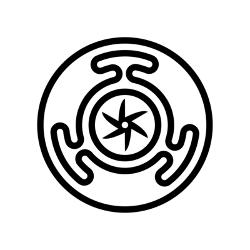“Traditional Witchcraft”, in Pagan circles, is often held as both a measure
and milestone. Likewise, it has become a point of contention and demarcation,
of discrimination and conflict. Envied or not, it lingers as a vague Holy Grail
amongst those who walk the Dark and Wyrd Ways.
Evenso, defining what exactly it is, seems to escape so many.
Take for example the definition of Paganism, which is often given as “non-Christian,
non-Muslim, non-Jew”. So too, Traditional Witchcraft is defined by what it is not:
“non-Gardnerian, non-Alexandrian, non-Wiccan”.
For a moment, I want to set aside the ‘traditional’ part to better focus on the ‘witch’
part. Today, for example, there are three words which are freely exchanged –
so mostly misunderstood – in Pagan circles: Shaman, Witch, and Seiðu (a practitioner
of Seiðr). In almost four decades of research and practice – skulking the scrolls
and weaving the runes – I have gleaned this understanding:
-Shamanism is the Eastern Siberian and northeast Asian spiritual healers,
story keepers, and intermediaries of and for their tribe. They draw from and work
with their tribal ancestors – who continue an active role in the daily life of the living.
I witnessed this first hand while living and training with Sami Noaide in Finland.
-Witchcraft is the scattered shamanic Old Ways of Old Europe; the fall-out left
from the Church’s decimation of the original Folkway (‘folk’, as in ‘kin, family;
bearers of an oral tradition’; ‘tribal way’).
–Seiðr is the “sacred” Old Ways of Old Europe. Akin to Shamanism, Seiðus
or Seiðbearers, traveled from one far stead to another, dispensing Wyrd –
via healing, tales, prophecy, and the like. Akin to Shamanism,
this too is a Spiritual Path, one that bears the oral traditions.
This is where ‘witch’ lost its ‘tradition’: During and after the Church’s 300 year war
against them. Sadly, the Traditional Roots of Witchcraft were deliberately dug-up,
scattered, and tainted – Covens, learning centers, and herbal hospitals, decimated or
destroyed. Today, we know this period in time – from the 15th to 18th centuries –
as both The Christianization, and The Burning Times.
Importantly, this is the demarcating line, when Witch’s went to ground,
hiding what remnants that remained; and it was not until the 1960’s CE
that these scattered Old Ways were made public once more.
Which is not to say that both Shamanism and Seiðr were spared the
Proverbial ‘rod’. What I am saying is that both still maintain a spiritual component
akin to that of their pre-Christian ancestry.
Witches and/or Wiccans today, for example, often contend that they are
“spiritual but not religious”; which means they are speaking out against the
organized religion of modern society. Yet, to truly embrace an ancestral folkway,
to be ‘traditional’, one must first understand how the pre-Christian Old Europeans
regarded ‘religion’. For example:
-The idea that religion and magic are two separate things / practices –
was unheard of among ancient Spirit Keepers.
-The idea that a God or other entity is ‘raised’, ‘called’, or ‘rides / possesses’
an individual, in a ‘created’ or ‘raised’ ‘cone of power’ or ‘high seat’,
is both alien and absurd.
-Groves and temples were necessary and permanent locations of worship.
The idea of ‘casting’ or ‘creating’ ‘sacred space’ stems from the Ceremonial Magic
of the Middle Ages; which equally opposed Nature and the Christian God.
-True sacrifice (or ‘all’ sacrifice) was done for serious threats, such as: food and
protection, wealth and right-rulership. Likewise, the idea of ‘calling’ a god(s) to
‘bless’ or ‘protect’, would have been unheard of. Clans and kindreds of yore
hoped the Tivar/Gods would accept their sacrifice, and in Their pleasure, grant a boon.
-There was never a unified or universally recognized calendar for all people
during every era. Likewise, the idea of ‘all gods are one god / the same’ would
have also been incongruous and contradictory to the pre-Christian Old Europeans.
-And finally (and yes, this must be made clear), the idea of gathering in the
nude was never a practice in the Old Ways.
Another interesting difference is that, today, many of those who identify as Witch,
Shaman or Seiðu, remain ‘solitary’ or unaffiliated with any coven, clan or kindred.
A situation that is not their fault. Sadly, modern Paganism –
in all its manifestations and denominations – has ostracized the very
individuals that their ancestors supported and respected. For example:
-Wiccans are often considered too “fluffy” or “commercialized”,
“cartoonish” or “lacking in history”;
-Witches are often considered too “arrogant” or “self-righteous”,
“ego-driven” or “seeking credentials”;
-Shamans are often considered “plastic” or “cultural appropriators”,
“lacking a tribe” or “core-shamans”
-Seiðus are often considered “too dangerous” or “too Wicca-tru”,
“cultural thieves” or “not having enough information”.
These derogatory insults come not from outsides, but fellow Pagans; from the
same communities these Spirit Keepers seek to be part of, to contribute towards,
and to assist in both worldly and other-worldly matters.
Finally, because my Craft includes reading academic papers from archaeology
and history, anthropology and ancient Pagan religion, I tend to view Traditional Craft
as something with a broader base. One that encompasses all of Old Europe.
So that, there are Hibernian, Caledonian and Britannian Crafts;
Teutonic and Celtic Crafts; Gallian and Gothic Crafts; Scandinavian and Sámi Crafts;
and all numerous sub-Crafts that merge two, three or more of these folkways.
Which brings us back to ‘traditional’, as in: What makes a Shamanic, Witch,
or Seiðr practice traditional? In my study, I have determined three threads:
-Their emphasis on research and application of that research;
-Their intuitive grasp of the whole and innate sense of All That Lives; and
-Their emphasis on attaining a higher spiritual perspective.
Put another way: The Three Threads that demarcate Traditional from new age are:
-Historical / Scholarly bedrock,
-Contemplative Insight,
-Devotion / Dedication to Deity.
Would You Know More, And What?
Your INVITATION to join us ..


Reblogged this on A Real Witch of Orange County.
LikeLike